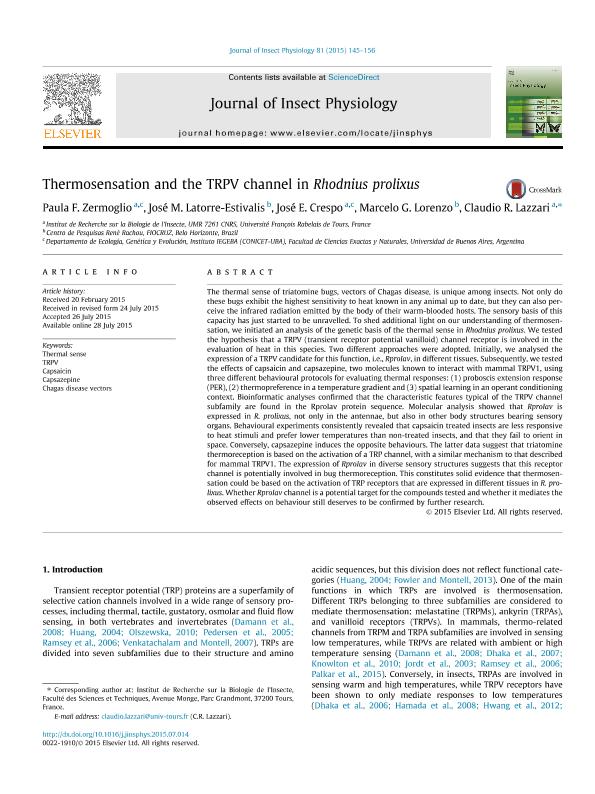Artículo
Thermosensation and the TRPV channel in Rhodnius prolixus
Zermoglio, Paula Florencia ; Latorre Estivalis, Jose Manuel
; Latorre Estivalis, Jose Manuel ; Crespo, José Emilio
; Crespo, José Emilio ; Lorenzo, Marcelo Gustavo
; Lorenzo, Marcelo Gustavo ; Lazzari, Claudio Ricardo
; Lazzari, Claudio Ricardo
 ; Latorre Estivalis, Jose Manuel
; Latorre Estivalis, Jose Manuel ; Crespo, José Emilio
; Crespo, José Emilio ; Lorenzo, Marcelo Gustavo
; Lorenzo, Marcelo Gustavo ; Lazzari, Claudio Ricardo
; Lazzari, Claudio Ricardo
Fecha de publicación:
10/2015
Editorial:
Pergamon-Elsevier Science Ltd
Revista:
Journal of Insect Physiology
ISSN:
0022-1910
Idioma:
Inglés
Tipo de recurso:
Artículo publicado
Clasificación temática:
Resumen
The thermal sense of triatomine bugs, vectors of Chagas disease, is unique among insects. Not only do these bugs exhibit the highest sensitivity to heat known in any animal up to date, but they can also perceive the infrared radiation emitted by the body of their warm-blooded hosts. The sensory basis of this capacity has just started to be unravelled. To shed additional light on our understanding of thermosensation, we initiated an analysis of the genetic basis of the thermal sense in Rhodnius prolixus. We tested the hypothesis that a TRPV (transient receptor potential vanilloid) channel receptor is involved in the evaluation of heat in this species. Two different approaches were adopted. Initially, we analysed the expression of a TRPV candidate for this function, i.e., RproIav, in different tissues. Subsequently, we tested the effects of capsaicin and capsazepine, two molecules known to interact with mammal TRPV1, using three different behavioural protocols for evaluating thermal responses: (1) proboscis extension response (PER), (2) thermopreference in a temperature gradient and (3) spatial learning in an operant conditioning context. Bioinformatic analyses confirmed that the characteristic features typical of the TRPV channel subfamily are found in the RproIav protein sequence. Molecular analysis showed that RproIav is expressed in R. prolixus, not only in the antennae, but also in other body structures bearing sensory organs. Behavioural experiments consistently revealed that capsaicin treated insects are less responsive to heat stimuli and prefer lower temperatures than non-treated insects, and that they fail to orient in space. Conversely, capsazepine induces the opposite behaviours. The latter data suggest that triatomine thermoreception is based on the activation of a TRP channel, with a similar mechanism to that described for mammal TRPV1. The expression of RproIav in diverse sensory structures suggests that this receptor channel is potentially involved in bug thermoreception. This constitutes solid evidence that thermosensation could be based on the activation of TRP receptors that are expressed in different tissues in R. prolixus. Whether RproIav channel is a potential target for the compounds tested and whether it mediates the observed effects on behaviour still deserves to be confirmed by further research.
Palabras clave:
Capsaicin
,
Capsazepine
,
Chagas Disease Vectors
,
Thermal Sense
,
Trpv
Archivos asociados
Licencia
Identificadores
Colecciones
Articulos(CCT - LA PLATA)
Articulos de CTRO.CIENTIFICO TECNOL.CONICET - LA PLATA
Articulos de CTRO.CIENTIFICO TECNOL.CONICET - LA PLATA
Articulos(IEGEBA)
Articulos de INSTITUTO DE ECOLOGIA, GENETICA Y EVOLUCION DE BS. AS
Articulos de INSTITUTO DE ECOLOGIA, GENETICA Y EVOLUCION DE BS. AS
Articulos(OCA CIUDAD UNIVERSITARIA)
Articulos de OFICINA DE COORDINACION ADMINISTRATIVA CIUDAD UNIVERSITARIA
Articulos de OFICINA DE COORDINACION ADMINISTRATIVA CIUDAD UNIVERSITARIA
Citación
Zermoglio, Paula Florencia; Latorre Estivalis, Jose Manuel; Crespo, José Emilio; Lorenzo, Marcelo Gustavo; Lazzari, Claudio Ricardo; Thermosensation and the TRPV channel in Rhodnius prolixus; Pergamon-Elsevier Science Ltd; Journal of Insect Physiology; 81; 10-2015; 145-156
Compartir
Altmétricas



